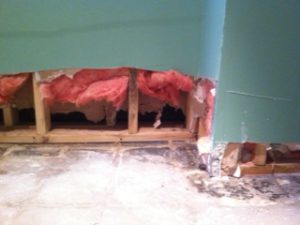Water and moisture inside of your home can cause a lot of damage. Some of it you can see, some of it you can’t. If you are a victim of the recent winter flooding in the St. Louis area we have several tips for you. The quicker you act the more likely you can prevent further damage from mold and mildew and protect your family as well.
Even if your basement has some dampness, it is the perfect breeding ground for mold that can be harmful and possibly fatal to you and your family. Mold can ruin walls, furniture and flooring but more importantly it can lead to poor indoor air quality and cause problems including asthma, trigger allergies and lead to severe illnesses. Even if you have already called your insurance company there are some steps you can take now to reduce the damage to your home and health. (Be sure to consult with your insurance company prior to making any repairs.)
Before you start you need to make sure you are protected. Flood water can contain raw sewage and harmful chemicals. Be sure that you are up to date on your tetanus booster.
6 Tips to Recover from Flooding or Water Damage
1. Disconnect power to prevent any electrical issues. Also, remove any electronics to keep the water from ruining the circuitry. Remove all other items. Once the room is empty start to remove the carpet, padding and tack strip. If you can get the carpet out and start to dry it, you may be able to salvage it.
2. Get rid of the water next. Depending on what is available to you, a sump pump, shop vac, towels and/or squeegees can help you to control and remove the water.
3. After you have removed the bulk of the water, drying out the affected area is the next step to reduce and hopefully prevent the growth of mold and mildew. Use fans, air movers, air scrubbers and/or a dehumidifier to dry everything out. If your basement was finished with drywall you will want to remove and wet drywall. If only a little water came in you can remove the bottom 2 feet of drywall which is half of one sheet (that way you save money on new materials), other wise you may need to cut it at 4 feet (a full sized sheet of drywall) or higher. Mold can grow on the drywall paper which is on the front and back of drywall. You could have mold growing inside of your walls and not even know it! Depending on the material, your insulation may also need to be removed.
4. Next you should start to disinfect after the area has dried out. A powerful disinfectant should be used on all areas and materials that touched flood water. Be sure to follow specific instructions from the manufacturer.
5. The next issue to tackle is mold growth. You can purchase products that inhibit mold growth in a spray bottle or a misting machine for your whole home. Again, follow the manufacturers directions.
6. If you ever sell your home in the future it is important that you disclose any flooding, roof leaks, water damage, sewer back ups and/or mold growth in the home. This not only protects a potential buyer, but also protects you from potential liabilities.
Sell Your Home To Us
Saint Louis Home Buyers purchases homes with water damage. If you have had issues with water getting into your home and are tired of dealing with repairs and clean up, you can sell it to us. We buy houses with basement leaks, sewer back ups and flooding issues. Call us today to help remove this headache from your life.

